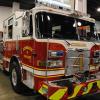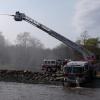
lalautze
Investors-
Content count
24 -
Joined
-
Last visited
Reputation Activity
-
x635 liked a post in a topic by lalautze in New FDNY Engine 34- 2013 Seagrave w/ High Pressure Pump
This is a pump that allows higher pressure discharges for high rise buildings. There are three impellers in the pump to boost the pressure 3 times allowing operators to overcome the elevation loss when crews are operating on upper floors of buildings that do not have fire pumps (or working fire pumps) on the standpipe system. This requires special high pressure hose to hook from the pumper into the FDC on the building but by the time the water gets to the fire floor you can use standard pressure hose since crews will experience normal pressures due to the elevation pressure loss. Without the ability to pump the proper pressure the crews will not have adequate pressure or flow to fight the fire. Think of how many buildings in Manhattan that are over 30 stories tall...
Most pumpers in the nation have either single or two stage pumps.
Hope this helps and its not too complicated.
-
x635 liked a post in a topic by lalautze in Squanz Engine Company-New Fairfield CT......How do they ring the bell?
Electric strikers exist so you just press a switch to ring the bell. There of course is an additional cost and maintenance associated with it compared to a string run into the cab to tug on.
I'm not sure if that is how this apparatus is set-up though.
-
firedude liked a post in a topic by lalautze in Pumper-Tankers
We have gone through a similar situation in our area.
Our department purchased a "rescue-engine" ten years ago and when we specified an engine in 2008 we chose not to go the "rescue-engine" route.
Our concerns with the 2002 design was the very high hose bed and ladder compartments. We find ourselves going to other trucks for hose and ladders because of this. Also this vehicle is a rear mount pump but all of the plumbing comes off the rear side compartments and takes up more space than I think it should. While the truck has lots of compartment space for rescue equipment included four coffins on top it suffers from easy access to some of the "bread & butter" structure firefighting equipment. While that stuff is accessed less often we find it hinders us on structure fires. This vehicle is the same overall dimensions as our other engines so handling and scene access are not an issue. Could some of the issues be resolved at the design stage? Possibly but we did not follow it up. I was not a member of the department when this vehicle was designed but I was around when it was delivered.
In 2008 we designed a "engine" with a rear rescue tool compartment. On this truck we specified that everything be accessible from the ground or one step up to the tailboard/running board. Everyone finds this truck much easier to operate and get equipment off of. The rear rescue tool compartment has a cutter & spreader attached to a pump with 100-foot reels. We carry some cribbing and struts in other compartments and find this covers 99% of our extrication calls. Also we returned to the top-mount pump panel which our older engines have and the members prefer. I was a member of the design committee for this truck.
Since we run a heavy rescue regardless we found that the "rescue-engine" design really didn't help us out any and made access to some equipment more difficult. I do not foresee us making a return to that design although I would admit that some of our issues could be resolved if the apparatus was designed differently.
Regarding the pumper-tanker. One of our neighboring departments replaced a pumper and tanker with a combination unit. All that I will say is that they got a tandem axle pumper-tanker and it does not handle or maneuver like an engine. When I see it on scene the apparatus takes awhile to get it down the drives and into position. Be aware of impact of size of the apparatus on your response area and operator driving abilities.
If you have any other questions let me know.
-
firedude liked a post in a topic by lalautze in Pumper-Tankers
We have gone through a similar situation in our area.
Our department purchased a "rescue-engine" ten years ago and when we specified an engine in 2008 we chose not to go the "rescue-engine" route.
Our concerns with the 2002 design was the very high hose bed and ladder compartments. We find ourselves going to other trucks for hose and ladders because of this. Also this vehicle is a rear mount pump but all of the plumbing comes off the rear side compartments and takes up more space than I think it should. While the truck has lots of compartment space for rescue equipment included four coffins on top it suffers from easy access to some of the "bread & butter" structure firefighting equipment. While that stuff is accessed less often we find it hinders us on structure fires. This vehicle is the same overall dimensions as our other engines so handling and scene access are not an issue. Could some of the issues be resolved at the design stage? Possibly but we did not follow it up. I was not a member of the department when this vehicle was designed but I was around when it was delivered.
In 2008 we designed a "engine" with a rear rescue tool compartment. On this truck we specified that everything be accessible from the ground or one step up to the tailboard/running board. Everyone finds this truck much easier to operate and get equipment off of. The rear rescue tool compartment has a cutter & spreader attached to a pump with 100-foot reels. We carry some cribbing and struts in other compartments and find this covers 99% of our extrication calls. Also we returned to the top-mount pump panel which our older engines have and the members prefer. I was a member of the design committee for this truck.
Since we run a heavy rescue regardless we found that the "rescue-engine" design really didn't help us out any and made access to some equipment more difficult. I do not foresee us making a return to that design although I would admit that some of our issues could be resolved if the apparatus was designed differently.
Regarding the pumper-tanker. One of our neighboring departments replaced a pumper and tanker with a combination unit. All that I will say is that they got a tandem axle pumper-tanker and it does not handle or maneuver like an engine. When I see it on scene the apparatus takes awhile to get it down the drives and into position. Be aware of impact of size of the apparatus on your response area and operator driving abilities.
If you have any other questions let me know.
-
firedude liked a post in a topic by lalautze in Pumper-Tankers
We have gone through a similar situation in our area.
Our department purchased a "rescue-engine" ten years ago and when we specified an engine in 2008 we chose not to go the "rescue-engine" route.
Our concerns with the 2002 design was the very high hose bed and ladder compartments. We find ourselves going to other trucks for hose and ladders because of this. Also this vehicle is a rear mount pump but all of the plumbing comes off the rear side compartments and takes up more space than I think it should. While the truck has lots of compartment space for rescue equipment included four coffins on top it suffers from easy access to some of the "bread & butter" structure firefighting equipment. While that stuff is accessed less often we find it hinders us on structure fires. This vehicle is the same overall dimensions as our other engines so handling and scene access are not an issue. Could some of the issues be resolved at the design stage? Possibly but we did not follow it up. I was not a member of the department when this vehicle was designed but I was around when it was delivered.
In 2008 we designed a "engine" with a rear rescue tool compartment. On this truck we specified that everything be accessible from the ground or one step up to the tailboard/running board. Everyone finds this truck much easier to operate and get equipment off of. The rear rescue tool compartment has a cutter & spreader attached to a pump with 100-foot reels. We carry some cribbing and struts in other compartments and find this covers 99% of our extrication calls. Also we returned to the top-mount pump panel which our older engines have and the members prefer. I was a member of the design committee for this truck.
Since we run a heavy rescue regardless we found that the "rescue-engine" design really didn't help us out any and made access to some equipment more difficult. I do not foresee us making a return to that design although I would admit that some of our issues could be resolved if the apparatus was designed differently.
Regarding the pumper-tanker. One of our neighboring departments replaced a pumper and tanker with a combination unit. All that I will say is that they got a tandem axle pumper-tanker and it does not handle or maneuver like an engine. When I see it on scene the apparatus takes awhile to get it down the drives and into position. Be aware of impact of size of the apparatus on your response area and operator driving abilities.
If you have any other questions let me know.
-
FF398 liked a post in a topic by lalautze in Show Off Your Marion Fire Apparatus
From the Midwest... Our last three apparatus have been Marion (2000 Rescue, 2002 Rear Mount Pumper, 2008 Top Mount Pumper)
-
firemoose827 liked a post in a topic by lalautze in Information About Multi-Gas Meters
We have two types of 4-Gas Meters in service, two MSA Solaris and six RKI GX-2001.
The MSA take a couple minutes to go through their start-up procedure but we have not had to replace sensors very often. They do not give accurate readings when the O2 sensor goes out which was a concern and part of the reason we switched to the RKI. I do not remember what we paid for them.
The RKI are what the department has been buying lately. They run $800 each and I seem to have to replace the O2 sensors every eight to twelve months at $100 a piece. We have a calibration station so we are able to do the repairs in house and I've started a detailed log to document how often I'm replacing sensors and how much money we are putting into these. These meters only have a 30 second start-up and do not reference the other readings off of the O2 sensor so I still get accurate CO, LEL, and H2S readings even when the O2 sensor is offline.
We recalibrate ours whenever a sensor is replaced or once a year.
The other city departments (streets/public works & water) use the RKI GX-2009 which we service and calibrate as needed (ie. when they are broken and come to us).
I'm not sure that we will be changing meter brands anytime soon but hope this information helps.
-
lalautze liked a post in a topic by firedude in Happy Birthday Seth AKA x635 AKA EMTBravo!
Laddies and Gentelmen of EMTBravo, today is Seth's (aka X635) Birthday. Seth is the Founder and Executive Director of this website and has put so much into this website. So, let me be the first to say....
HAPPY BIRTHDAY SETH!!!
-
FF398 liked a post in a topic by lalautze in Show Off Your Marion Fire Apparatus
From the Midwest... Our last three apparatus have been Marion (2000 Rescue, 2002 Rear Mount Pumper, 2008 Top Mount Pumper)
-
x635 liked a post in a topic by lalautze in Apology For Recent EMTBravo Downtime
Seth,
I, as well as most (if not all) of the membership, appreciate the time and effort you put into this. Thanks for keeping things running and upgrading the systems as needed.
-
efdcapt115 liked a post in a topic by lalautze in Foam 101
You need to provide nozzle pressure at the nozzle which sounds like you have 100psi fog nozzles. Eductors have high friction loss due to their design so it is very possible to have pump pressures of 150-200psi to get your needed 100psi at the nozzle. Check the manuals for the eductors you use, they should have a required intake pressure on them.
Our eductors are 150psi at the intake but depending on friction loss in the hose lay we can pump close to 200psi for a 100psi fog nozzle.
We have Class A Foam systems on our last 2 engines (25-gallon tanks) and a Class B AR-AFFF Foam Trailer (550-gallons). The Class A system does help with extinguishing typical structure fire and does a good job on vehicles and dumpsters too. The foam trailer is for all of the tanker trucks and trains we have going thru town. With a pipeline terminal we get everything from diesel to gasoline to aviation fuel plus this is Iowa so there is quite a bit of ethanol as well. The Class A systems are injection via computer and the Class B trailer we use eductors. No SOG for use of the Class A, we train to use it on everything but we do have a SOG for the Class B since you have to calculate how much foam you need for the given fire size, duration, etc.




